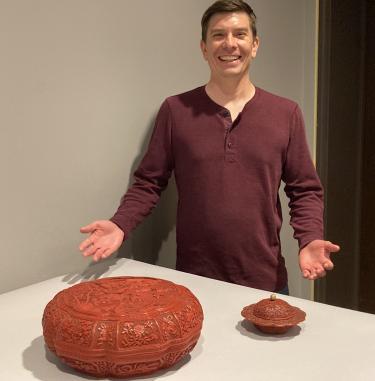Covered Foliate Box with Figure, Landscape, Floral and Eight Auspicious Symbols Design
Chinese; Qing dynasty, 18th century
Carver red lacquer (over wooden core)
Murray Warner Collection, MWCH8:5
Covered Bowl with Buddhist and Daoist Symbols Design
Chinese; Qing dynasty (1644-1912)
Carver red lacquer (over wooden core)
Murray Warner Collection, MWCH8:6
The images on these two boxes were produced by carving into multiple layers of lacquer. The use of lacquer in China dates back to the Neolithic period, with carving introduced during the Tang dynasty (618-907). The production of carved lacquers reached its height of popularity during the Ming (1368-1644) and Qing (1644-1912) dynasties. Emperor Qianlong (ruled 1735-1796) seems to have developed a personal predilection for this art, commissioning several sets during his lifetime. The production of carved lacquer requires many layers to be built upon a suitable base, usually of wood or sometimes metal, leather, or paper-mâché. Commonly a piece goes through 30 to 35 applications of lacquer, but exceptional pieces can even have up to 200 layers. For this reason, a single work can take months or even years to complete, because after the application of each thin layer the piece must be allowed to cure before the next layer can be applied. Only then can the delicate carving work begin.
The lid of the larger red foliate lacquer box is decorated with a scene depicting the Eight Daoist Immortals. A large vase carried by two servants represents the peaches of immortality. The bald figure carrying a staff is Shou Lao, his enlarged head indicating his accumulation of wisdom acquired through meditation. A pine tree symbolizing friendship provides shade for the figures. The varied geometric diaper patterns in the background indicate demarcations between earth, water, and air. These designs vary with the most pronounced pattern used for earth and the most delicate for air. Around the sides is a squared spiral pattern mimicking ancient bronze decoration, which shows the influence that early bronzes continued to have on later art. The eight quadrants are decorated with the eight auspicious symbols of Buddhism. The conch symbolizes the Buddhist call to prayer, the Dharma
wheel represents the teachings of Buddha, the fish symbolize fertility and abundance, the endless knot stands for Buddha’s infinite wisdom, the lotus symbolizes purity and enlightenment, the parasol represents royalty and protection, the treasure vase contains long life and spiritual abundance, and the banner represents the victory of wisdom over ignorance and temptation.
The smaller carved box has a brass handle and a twelve-petal base. Its sides are also decorated with the eight Buddhist symbols over a background of delicate swirling clouds and auspicious bats.
— Andrew Vitt






